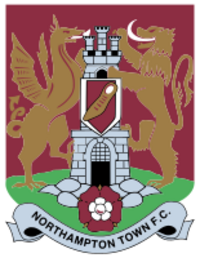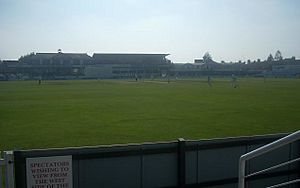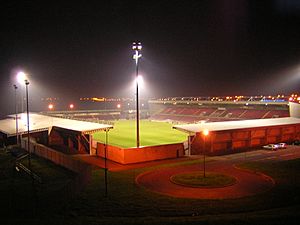Northampton Town F.C. facts for kids
 |
|||
| Full name | Northampton Town Football Club | ||
|---|---|---|---|
| Nickname(s) | The Cobblers Shoe Army Teyn |
||
| Founded | 9 March 1897 | ||
| Ground | Sixfields Stadium | ||
| Capacity | 8,203 | ||
| Chairman | Kelvin Thomas | ||
| Manager | Kevin Nolan | ||
| League | League Two | ||
| 2018–19 | League Two, 15th of 24 | ||
|
|||
Northampton Town Football Club is a professional association football team from Northampton, England. They are known as the Cobblers. This nickname comes from the town's history of making shoes. The team plays in claret and white kits.
Northampton Town was started in 1897. They played in different leagues before joining the English Football League in 1920. The club had a very exciting time from 1960 to 1965. They moved up from the fourth division to the top division of English football in just five years! This was their only season in the top league.
After that, they went back down to the lower divisions. The team has had many ups and downs, including promotions and relegations. In 2020, they won a play-off final to get promoted to EFL League One. They were relegated again in 2021 but earned another promotion back to League One in 2023.
The Cobblers played at the County Ground until 1994. Then they moved to their current home, Sixfields Stadium. This stadium can hold 8,203 fans. Northampton's main rivals are Peterborough United. Their matches are called the Nene derby.
Contents
Club History
How Northampton Town Started
Northampton Town Football Club was founded on March 6, 1897. A group of local school teachers and a lawyer named A.J. "Pat" Darnell created the town's first professional football club. They first wanted to call it Northampton Football Club. But the town's rugby club objected, so they chose Northampton Town Football Club instead.
The team joined the Northants League and won the championship in their second season. They then played in the Midland League before joining the Southern Football League in 1901. In 1908–09, led by player-manager Herbert Chapman, they became champions of the Southern League. This allowed them to play against Newcastle United in the Charity Shield match, which they lost 2–0.
Joining the Football League
After World War I, in 1920, Northampton Town joined the Football League in Division Three (South). In 1922–23, the club became a public company. They sold 8,000 shares to raise money. That season, a record crowd of 18,123 fans watched them play against Plymouth.
In 1923–24, the club raised £5,000 to build a new stand and improve the stadium. A supporters' club was formed the next season. In 1925, the club made its first international player transfer, signing William Shaw from Barcelona. A new record crowd of 21,148 came to watch an F.A. Cup replay against Sunderland. Sadly, in December 1929, a fire destroyed three stands at the County Ground. The stands were rebuilt by August 1930.
Exciting Times and Challenges
In 1932–33, brothers Fred and Albert Dawes both scored in an 8–0 win. Albert Dawes scored 32 league goals that season. He even scored four goals in a game against the Netherlands national football team while the club was on tour. In 1933–34, the team reached the F.A. Cup fifth round for the first time. They lost to Preston North End in front of a record crowd of 40,180.
Before World War II, the Cobblers finished in the middle of Division Three (South). In their last match before the war, they lost 10–0, which is still the club's record league defeat.
The Rise to the Top Division
Northampton Town had an amazing period from 1960 to 1965. They were promoted three times in five years! Starting in the Football League Fourth Division, they reached the Football League First Division in 1965–66. This was their only season ever in the top division of English football. During this time, they beat teams like Aston Villa, Leeds, and West Ham.
The Fall and Rebuilding
After their season in the top flight, Northampton was relegated back to the Fourth Division by 1969. This meant they went from the fourth tier to the first and back in just nine years, setting a record.
In 1970, they lost 8–2 to Manchester United in the FA Cup. Six of those goals were scored by the famous player George Best. In 1971, the club had to apply to stay in the league, which they did. In 1975, future England player Phil Neal was sold to Liverpool for a club record fee.
In the 1975–76 season, the club finished second in Division Four and were promoted. They did not lose a single home game that season. They were relegated back to Division Four in 1977.
The 1980s: Ups and Downs
New floodlights were installed in 1980, but they failed during the first match! The club struggled in the lower half of the Fourth Division for a while. In 1984, 16-year-old Aidy Mann became the club's youngest player.
In 1984–85, the lowest ever league attendance at the County Ground was recorded: only 942 people watched the Cobblers lose to Chester City. The club hired Tony Barton, who had won the European Cup with Aston Villa. But his time as manager was disappointing.
Success came under Graham Carr, who brought in new players. The 1986–87 season saw Northampton win the Fourth Division championship. They earned a club record 99 points and scored 103 goals. Player Richard Hill scored 29 of those goals. The team adjusted well to Division Three, but important players were sold, and they went back down to Division Four by 1990.
Challenges in the Early 1990s
The 1990s started tough. The club was relegated to the Fourth Division in 1990. In April 1992, the club faced serious financial problems and went into administration. Many players were let go, and youth players had to step in. These events led to the creation of the Northampton Town Supporters' trust. This group of fans helped take over the club.
In 1992–93, the club needed to win their final game to avoid being relegated out of the Football League. Over 2,500 fans traveled to Shrewsbury Town and saw the Cobblers win 3–2, even after being 2–0 down. In 1993–94, the Cobblers finished last in the Football League. They only avoided relegation because the champions of the lower league, Kidderminster Harriers, did not meet stadium requirements.
The Sixfields Era Begins
The club moved to its new home, Sixfields Stadium, in October 1994. In their 100th anniversary season (1996–97), manager Ian Atkins led the Cobblers to Wembley Stadium for the first time. They beat Swansea City 1–0 in the play-off final, with John Frain scoring the winning goal.
The next season, Northampton reached another play-off final but lost to Grimsby Town. Over 40,000 Northampton fans attended, which was a record for supporters taken to Wembley by one team at that time. In 1998–99, many players got long-term injuries, and the team was relegated. However, they bounced back immediately in 1999–2000, earning automatic promotion back to Division Two.
After a few tough seasons, the club faced financial difficulties again in the early 2000s. They launched a "Save our Season" campaign. In 2003, Colin Calderwood became manager. He led Northampton to the play-offs in his first season. In 2005–06, the Cobblers earned promotion to Football League One.
In 2010, Northampton caused a big upset in the 2010–11 Football League Cup. They beat Liverpool at Anfield in a penalty shootout! Manager Ian Sampson was sacked in 2011 after a poor run of games. Aidy Boothroyd took over and helped the team avoid relegation. In 2013, Northampton reached the League Two play-off final but lost to Bradford City.
In 2014, Chris Wilder became the new manager. In October 2015, the club faced financial issues again. But in February 2016, Northampton Town broke their club record with nine wins in a row. The 2015–16 season was very successful, and they won the League Two championship.
In 2017, a Chinese company, 5uSport, bought a 60% stake in the club. This brought new investment. Jimmy Floyd Hasselbaink became manager in September 2017 but was replaced by Keith Curle in 2018.
On June 29, 2020, the club was promoted to EFL League One after beating Exeter City 4–0 in the play-off final. This was a great win, especially after the season was delayed by the COVID-19 pandemic. However, they were relegated back to League Two after just one season.
In the 2021–22 season, Northampton finished fourth. They just missed out on automatic promotion on the final day. They lost in the play-off semi-finals. But in the following season, 2022–23, they secured automatic promotion back to League One on the final day of the season!
Club Identity
Team Colors and Sponsors
Northampton's team kit has been made by Puma since 2023. Before that, other companies like Adidas, Umbro, Nike, and Hummel made their kits.
The club's shirts are sponsored by the University of Northampton and PTS Academy. Many other companies have sponsored their shirts over the years, including Chronicle & Echo and Nationwide.
Stadiums
County Ground History
Northampton Town played at the County Ground from 1897 to 1994. They shared it with the Northamptonshire County Cricket Club. The main stand was demolished in 1985 because it was unsafe after a stadium fire elsewhere.
The County Ground saw its highest attendance of 24,523 on April 23, 1966. This was during an important game against Fulham. It also saw Northampton's lowest ever attendance in the Football League: only 942 people for a match against Chester City in 1984–85. The last game played at the County Ground was on October 12, 1994.
Sixfields Stadium Today
The club moved to Sixfields Stadium in 1994. It is a modern stadium where all fans have seats. It can hold 7,653 people. The stadium has a large west stand that seats 4,000. Opposite it is the smaller east stand, known as the Alwyn Hargrave stand. The stands at each end are the same height as the east stand. The south stand is usually for away supporters. The north stand is called the Sheinman Opticians Stand.
The stadium was briefly renamed the PTS Academy Stadium in 2018. But in July 2021, its name went back to Sixfields Stadium.
The team trains at Moulton College in Moulton, Northampton, since July 2016.
Supporters and Rivalries
Northampton Town's biggest rivals are Peterborough United. This rivalry has been strong since the 1960s. Games between these two clubs are called the Nene derby. This name comes from the river that connects Northampton and Peterborough.
Other teams that Northampton has rivalries with include Oxford United, Milton Keynes Dons, Coventry City, and Cambridge United.
Club Records
Northampton Town holds a unique record in English football. They are the club that moved from the fourth tier to the first tier and back down to the fourth tier in the shortest time: just nine years!
Tommy Fowler has played the most games for Northampton Town. He played 552 matches between 1946 and 1961. Ian Sampson, a former captain, is second with 449 games. The goalkeeper with the most appearances is Peter Gleasure, who played 412 games.
Jack English is the club's top goal scorer. He scored 143 goals in competitive matches between 1947 and 1959.
The highest attendance at the County Ground was 24,523. This happened on April 23, 1966, for a game against Fulham. The record attendance at Sixfields Stadium is 7,947. This was for a game against Birmingham City on March 15, 2025.
Club Achievements
Northampton Town has won several titles and promotions throughout its history:
- Second Division (level 2)
- Runners-up: 1964–65
- Third Division South / Third Division (level 3)
- Champions: 1962–63
- Runners-up: 1927–28, 1949–50
- Fourth Division / League Two (level 4)
- Champions: 1986–87, 2015–16
- Runners-up: 1975–76, 2005–06
- Promoted: 1960–61, 1999–2000, 2022–23
- Play-off winners: 1997, 2020
- Southern Football League
- Champions: 1908–09
- Runners-up: 1910–11
Cup
- FA Charity Shield
- Runners-up: 1909
See also
 In Spanish: Northampton Town Football Club para niños
In Spanish: Northampton Town Football Club para niños



